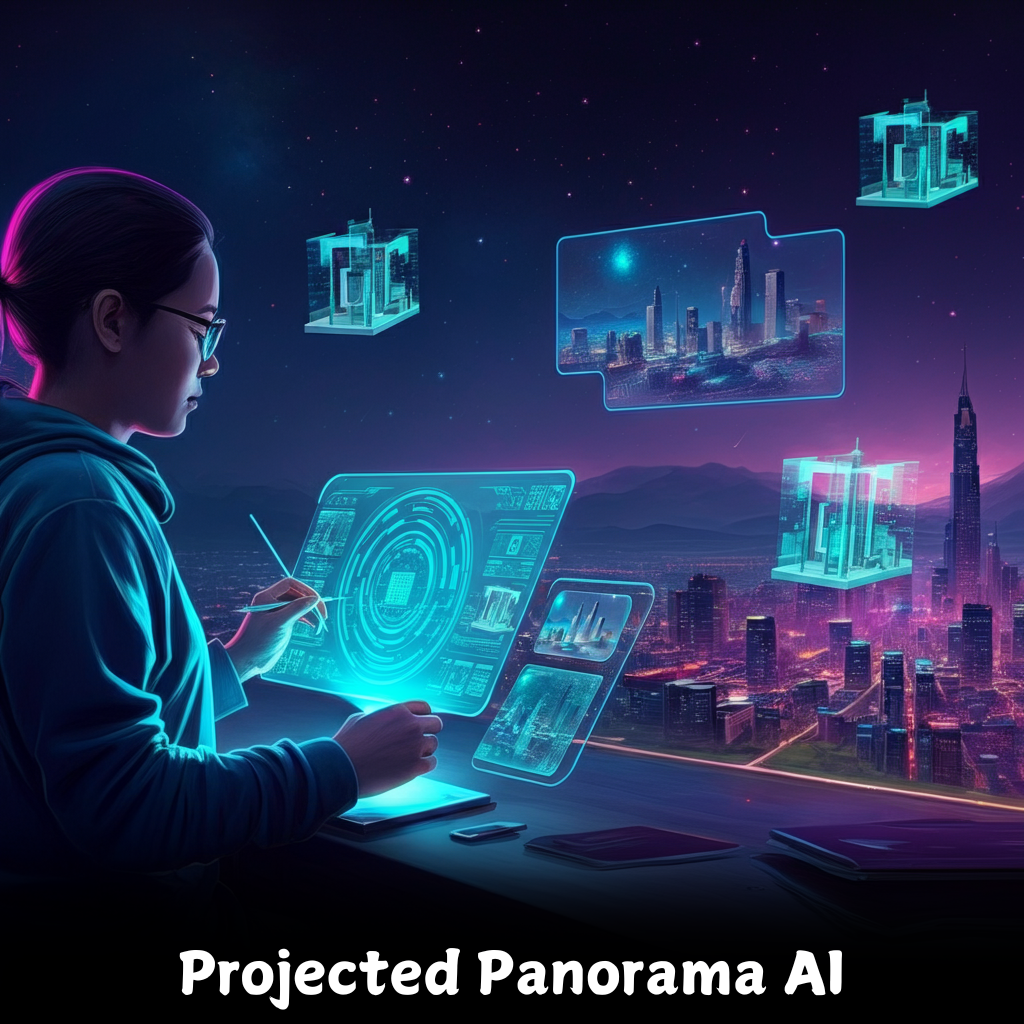Panoramic images have always fascinated us, offering immersive views that go beyond the limitations of a traditional photo. Whether it’s the sweeping landscapes of a mountain range, the intricate details of a bustling cityscape, or the endless expanse of the ocean, panoramic photography has the power to transport us into a scene. But as stunning as they are, creating crisp, seamless panoramas isn’t always easy that’s where Projected Panorama AI comes in.
This innovative technology is transforming panoramic image creation, making the process faster, more efficient, and, most importantly, more stunning. By integrating advanced artificial intelligence (AI) algorithms, photographers, digital artists, and even researchers can now produce panoramas that are more precise, visually compelling, and tailored to their needs.
If you’re intrigued by the possibilities of AI-powered panoramas, let’s explore how this technology works, its applications, and how you can harness it to create your own stunning images.
What Is Projected Panorama AI?
Projected Panorama AI refers to the use of artificial intelligence in the creation of panoramic images through sophisticated projection techniques. Traditional panorama processes rely on manual stitching or basic software that faces challenges such as parallax errors, inconsistent lighting, and alignment issues. AI-powered solutions, however, leverage machine learning and computer vision to enhance these processes dramatically.
With Projected Panorama AI, you’ll get solutions that automatically analyze and combine overlapping images into a cohesive whole, correcting distortions and ensuring the final product is both accurate and immersive.
Whether you’re an amateur photographer, a professional artist, or someone working in fields like virtual reality or geospatial mapping, this cutting-edge approach unlocks endless possibilities for creativity and precision.
How Does Projected Panorama AI Work?
1. AI in Image Stitching
At the core of Projected Panorama AI is image stitching, powered by deep learning and neural networks. Unlike traditional methods prone to errors, AI excels in seamlessly merging images.
Here’s what it does:
- Detects Key Points: AI identifies matching features between images, regardless of overlaps or inconsistencies in lighting.
- Corrects Distortions: Advanced algorithms automatically adjust for lens distortions and perspective shifts.
- Blends Seamlessly: AI creates smooth transitions between image boundaries, erasing visible seams for a flawless panorama.
For example, tools like PTGui and Adobe Lightroom use AI to handle extremely complex scenes where traditional stitching software often struggles.
2. Advanced Projection Algorithms
After the stitching process, the next step is projection—mapping the panorama onto your chosen surface (such as a cylindrical or spherical projection).
AI-based projection algorithms:
- Preserve Spatial Relationships to avoid disproportionate or distorted details.
- Enhance Visual Quality by balancing colors, contrasts, and textures across the entire panorama.
- Offer Customizability so users can experiment with unique projection techniques suited to their vision.
Applications of Projected Panorama AI
The versatility of Projected Panorama AI has resulted in applications across various industries. Here are just a few ways this technology is being used today:
1. Virtual Reality & Immersive Experiences
Virtual reality developers rely on panoramic images to create immersive environments. AI-powered panoramas enable sharper, distortion-free visuals, enhancing the user’s sense of “stepping into another world.”
2. Architectural Visualization
Architects and interior designers often use panoramic renderings to showcase structures and interiors to clients. Projected Panorama AI ensures accurate alignment, making the visuals both realistic and captivating.
3. Digital Art & Creativity
For digital artists, Projected Panorama AI opens up new creative possibilities. Whether it’s designing interactive exhibits, 360° artworks, or experiential installations, the AI provides tools to experiment with wide-angle compositions like never before.
4. Geospatial Mapping & Environmental Studies
AI-driven panoramic tools play an essential role in mapping data from aerial imagery or satellite imagery. For example, researchers use these panoramas to track environmental changes, explore terrain, and develop urban planning projects.
Key Benefits of Using Projected Panorama AI
- Enhanced Accuracy: AI detects errors in alignment and seamlessly stitches even the most complex scenes.
- Time Savings: Automation allows for quicker processing, freeing up valuable hours.
- Creative Versatility: Enables customization of projections, so creators can explore unique outputs.
- Cost-Efficiency: Reducing manual intervention saves both time and money.
- Engaging Visuals: Produces polished, high-quality images that leave a lasting impression.
Expert Tip
“AI has revolutionized photography creativity. Tools like Projected Panorama AI allow professionals to focus more on storytelling while letting the technology handle the precision,” says acclaimed VR content creator, Lara Nielsen.
Step-by-Step Guide to Creating a Projected Panorama with AI
Step 1. Capture Your Images
- Use a tripod to maintain alignment.
- Capture images with at least 20%-30% overlap in the frame for better stitching accuracy.
- Keep lighting conditions consistent to minimize extensive post-editing.
Step 2. Pre-Processing
- Lens Calibration: Correct any lens distortions through software.
- Consistency: Adjust exposure, white balance, and color grading for uniformity.
Step 3. AI-Driven Image Stitching
- Import your photos into an AI-enabled software tool (like AutoStitch or Hugin).
- Allow the AI to match keypoints, align images, and merge seamlessly.
Step 4. Projection & Adjustments
- Choose your projection type (cylindrical, spherical, or custom).
- Preview and make adjustments to perspective or colors for the desired output.
Step 5. Post-Processing
- Add final touches such as noise reduction, sharpening, or artistic filters.
- Export your finished image in high resolution for sharing or printing.
Challenges and Future Directions
While Projected Panorama AI is impressive, challenges like handling dynamic scenes and high computational demands remain. However, advancements in hardware and neural networks are making these tools more accessible every day.
Looking ahead, expect Projected Panorama AI to integrate more deeply with virtual reality (VR) and augmented reality (AR), paving the way for even more immersive and practical applications.
FAQs
1. What makes AI-powered panoramas better than traditional ones?
AI ensures seamless stitching without distortions, can handle complex environments, and offers faster, more accurate results compared to manual methods.
2. Can beginners use Projected Panorama AI tools?
Absolutely! Many platforms like PTGui and AutoStitch come with intuitive interfaces designed for users of all skill levels.
3. Does Projected Panorama AI only work for photos?
No—this technology supports video footage as well, which is particularly beneficial for VR applications.
4. What industries benefit most from projected panoramas?
Industries like VR, architecture, environmental science, and digital art frequently use this technology for visual storytelling and data representation.
5. What’s the best software for creating AI-driven panoramas?
Some top picks include AutoStitch, Hugin, and Adobe Lightroom for their user-friendly features and advanced AI capabilities.
Unlock the Future of Panoramic Storytelling
Projected Panorama AI isn’t just a tool—it’s a gateway to creating visuals that captivate, inform, and inspire. Whether you’re showcasing a new architectural concept, crafting a VR experience, or exploring environmental data, this technology offers a precision and creative freedom unimaginable a decade ago.
Now that you’ve got the basics down, why stop here? Grab an AI-powered tool, experiment with capturing the perfect shots, and start stitching your way to breathtaking panoramas. The future of photography has never been more exciting.



